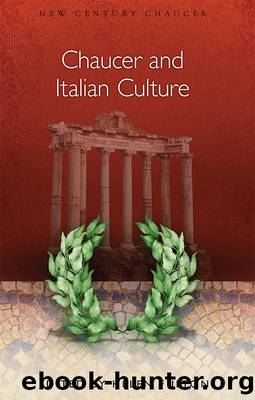Chaucer and Italian Culture by Helen Fulton;

Author:Helen Fulton;
Language: eng
Format: epub
Publisher: Lightning Source Inc. (Tier 3)
6
THE PROPHETIC EAGLE IN ITALY, ENGLAND AND WALES: DANTE, CHAUCER AND INSULAR POLITICAL PROPHECY
Victoria Flood
This chapter considers Chaucerâs House of Fame in relation to political prophetic interests at work in Danteâs Commedia and a roughly contemporary insular tradition of politicised apocalypticism drawing on similar currents in pan-European circulation. A number of critics have argued persuasively that, in his House of Fame, Chaucer offered a pastiche of contemporary apocalyptic and visionary motifs. This has generally been understood as a jibe at the pretensions of visionary literature (including Danteâs Commedia) to a privileged form of knowledge â as Helen Cooper has put it, a sense that âthis side of death, judgement is human, provisional, uncertain, and quite possibly wrongâ.1 In this respect, the House of Fame represents one of a number of medieval texts that cultivate an association between apocalypticism, authorship and authority â however unstable this configuration is for Chaucer.2 Despite this critical interest, Chaucerâs apocalypticism has yet to be located by scholars in the broader context of what was a significant engagement with and contemporary circulation of prophetic literature. Revelatory material was by no means necessarily politically neutral during this period, and the later Middle Ages saw a flourishing of apocalyptic and imperially minded political prophecy in the medieval West, drawn on by politically engaged authors and compilers from southern Italy to Wales.3
This chapter follows a westward geo-political trajectory, taking in Italy, England and Wales, with two aims in mind: the contextualisation of what I understand to be Chaucerâs rejection of a dominant continental source tradition in pan-European transmission; and Chaucerâs insular context, in evidence in the interaction between English and Welsh prophecy, without which, as I have argued elsewhere, we cannot understand the long historical development of prophecy in medieval Britain.4 This study is therefore concerned with the porous boundaries between medieval linguistic and cultural contexts. It is conducted not with specific source analysis in mind (although on occasion source relationships are suggested), but rather with an emphasis on the broad diffusion of a common prophetic motif â the figure of the eagle, whose revelatory and imperialist potential is both invoked and denied by Chaucer â across different political and social milieux in late medieval Europe. This mode of analysis takes its cue from the recent interest in the âitineraryâ approach to European literatures, championed by David Wallace â the study of a theme in pan-European circulation, viewed from the vantage point of three very specific, although inter-related, geo-political contexts.5
Danteâs Joachism and Chaucerâs Eagle
Danteâs engagements with political prophecy have been understood as inspired by the prophetic exegeses of Joachim of Fiore (c.1135â1202), a Calabrian abbot and founder of the monastery of San Giovani, and the prophecies produced in imitation of him.6 A prophetic vogue beginning in southern Italy during the early thirteenth century, political Joachite texts circulated fairly rapidly across Europe. Joachite prophecy takes its impetus from a tripartite understanding of history, found in Joachimâs genuine prophetic writings, which proposed three chronological epochs, the Age of the Father (articulated
Download
This site does not store any files on its server. We only index and link to content provided by other sites. Please contact the content providers to delete copyright contents if any and email us, we'll remove relevant links or contents immediately.
| Belgium | France |
| Germany | Great Britain |
| Greenland | Italy |
| Netherlands | Romania |
| Scandinavia |
Room 212 by Kate Stewart(4116)
The Crown by Robert Lacey(4115)
Endurance: Shackleton's Incredible Voyage by Alfred Lansing(3856)
The Iron Duke by The Iron Duke(3650)
The Rape of Nanking by Iris Chang(3526)
Killing England by Bill O'Reilly(3461)
Joan of Arc by Mary Gordon(3270)
Say Nothing by Patrick Radden Keefe(3069)
I'll Give You the Sun by Jandy Nelson(2847)
Hitler's Monsters by Eric Kurlander(2737)
Shadow of Night by Deborah Harkness(2731)
Margaret Thatcher: The Autobiography by Thatcher Margaret(2689)
Mary, Queen of Scots, and the Murder of Lord Darnley by Alison Weir(2682)
Darkest Hour by Anthony McCarten(2650)
Blood and Sand by Alex Von Tunzelmann(2611)
Red Famine: Stalin's War on Ukraine by Anne Applebaum(2470)
Eleanor & Park by Rainbow Rowell(2399)
The One Memory of Flora Banks by Emily Barr(2351)
Book of Life by Deborah Harkness(2274)
